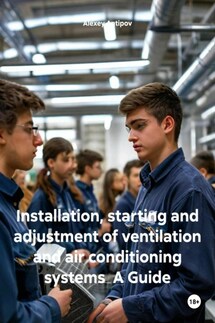Installation, starting and adjustment of ventilation and air conditioning systems A Guide - страница 16
Exhaust grilles can also have flow and direction regulators. Some grid designs are universal and are used in both supply and exhaust systems.
Grilles are installed more often on the walls above the serviced area. At the same time, they can be specially designed for installation in the ceiling (for exhaust, inflow or universal).
5.2. Air distributors
The supply of the air in ducted and ductless air distribution systems is carried out in the form of jets.
Table 5.1 shows the schemes of air distribution devices and their main characteristics: aerodynamic coefficient m, temperature coefficient n and local resistance coefficient ξ. The coefficients m and n characterize the rate of attenuation of air velocity and temperature in the supply jet.Such indicators are necessary to calculate the speed and temperature of the air in the working area of the premises.
Table 5.1. Characteristics of air distribution devices
The choice of air supply methods depends on the height and purpose of the premises, the height and placement options of the equipment, as well as on the requirements for the uniformity of the distribution of air parameters.
Choosing the methods of air supply and removal, at the same time pre-select the supply and exhaust air distribution devices, their number and placement options relative to each other. The joint choice of air supply and removal methods is practically determined by the choice of the air distribution method in this room.
The applied methods of air distribution are characterized depending on the direction of movement of the air supplied to the premises: "from top to bottom", if the supply occurs in the upper zone, and removal – in the working; "from top to top", if the supply and removal of air occur in the upper zone of the premises, as a rule, this method ensures the movement of the supplied flows above the working level zones, and in the working area, the set air velocity is created by the reverse flow; "side up", etc. When choosing the method of air distribution, the direction of heat flows and the areas of the premises characterized by the maximum intake of heat or moisture are taken into account.
If it’s necessary to provide increased air velocity in air conditioning systems with an increased value of the height of the working area of the premises (hP. Z > 2 m) it’s possible to provide air distribution through conical nozzles.
The aerodynamic coefficient of conical nozzles m varies in a wide range, and its values depend on the angle of taper of the nozzle. Conical nozzles are characterized by the highest (maximum possible) values of the aerodynamic coefficient. As the taper angle increases, the value of m also increases. At the same time, the maximum value of m = 7.7 … 7.8. Simultaneously with an increase in m, the coefficient of local resistance also changes significantly. Figure 5.1 shows a diagram of a cylindrical nozzle with preload.
Supply grilles of various designs, ceiling lampshades and diffusers are also widely used, capable of working as supply and exhaust devices.
In rooms of small height (up to 5 m), air distribution can be carried out through perforated panels mounted in the ceiling. In this case, the normative mobility of air in the working area is achieved with a large multiplicity of air exchange. Perforation holes are made with a diameter of 2 to 10 mm, the area of the living section of the panel does not exceed 10% of the total area of the panel.






